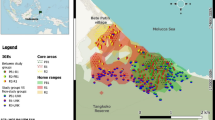Abstract
We studied intergroup encounters among moor macaques at the Karaenta Nature Reserve, South Sulawesi, Indonesia. Group B has been observed on the basis of individual identification since 1988. We analyzed 85 encounters between members of Group B and members of neighboring groups from September 1990 to November 1998. The average frequency of intergroup encounters was 0.035/hour. Neither the presence of females in estrus nor rainfall had an effect on encounter frequency. Behaviors of moor macaques during intergroup encounters differed from those of Japanese macaques. In moor macaques, no intergroup interactions with body contact were observed during encounters, and females never directed aggression toward members of different groups. The present study did not confirm the prediction of the model ofvan Schaik (1989). Extension of the existing models is required to explain the difference in female dominance styles among macaques by socioecological factors.
Similar content being viewed by others
References
Cheney, D. L. 1987. Interactions and relationships between groups. In:Primate Societies,Smuts,B. B.;Cheney,D. L.;Seyfarth,R. M.;Wrangham,R. W.;Struhsaker,T. T. (eds.), The Univ. of Chicago Press, Chicago, pp. 267–281.
Cheney, D. L. 1992. Intragroup cohesion and intergroup hostility: the relation between grooming distributions and intergroup competition among female primates.Behav. Ecol., 3: 334–345.
Davies, N. B. (1991). Mating systems. In:Behavioral Ecology: An Evolutionary Approach (3rd ed.),Krebs, J. R.;Davies, N. B. (eds.),Blackwell, Oxford, pp. 263–294.
de Waal, F. B. M.;Luttrell, L. M. 1989. Toward a comparative socioecology of the genusMacaca: different dominance styles in rhesus and stumptail monkeys.Amer. J. Primatol., 19: 83–109.
Isbell, L. A. 1991. Contest and scramble competition: patterns of female aggression and ranging behavior among primates.Behav. Ecol., 2: 143–155.
Kawanaka, K. 1973. Inter-troop relations among Japanese monkeys.Primates, 14: 113–159.
Kumar, A.;Kurup, G. U. 1985. Inter-troop interactions in the lion-tailed macaque,Macaca silenus. In:The Lion-tailed Macaque: Status and Conservation,Heltne,P. G. (ed.), Alan R. Liss, New York, pp. 91–107.
Matsumura, S. 1998. Relaxed dominance relations among female moor macaques (Macaca maurus) in their natural habitat, South Sulawesi, Indonesia.Folia Primatol., 69: 346–356.
Matsumura, S. 1999. The evolution of “egalitarian” and “despotic” social systems among macaques.Primates, 40: 23–31.
Mehlman, P. T.;Parkhill, R. S. 1988. Intergroup interactions in wild barbary macaques (Macaca sylvanus), Ghomaran Rif Mountains, Morocco.Amer. J. Primatol., 15: 31–44.
Mitani, M. 1999. Does fruiting phenology vary with fruit syndrome? An investigation on animal-dispersed tree species in an evergreen forest in south-western Cameroon.Ecol. Res., 14: 371–382.
Oi, T. 1990. Population organization of wild pig-tailed macaques (Macaca nemestrina nemestrina) in West Sumatra.Primates, 31: 15–31.
Okamoto, K.;Matsumura, S.;Watanabe, K. 2000. Life history and demography of wild moor macaques (Macaca maurus): summary of ten years of observations.Amer. J. Primatol., 52: 1–11.
Perry, S. 1996. Intergroup encounters in wild white-faced capuchins (Cebus capucinus).Int. J. Primatol., 17: 309–330.
Saito, C.;Sato, S.;Suzuki, S.;Sugiura, H.;Agetsuma, N.;Takahata, Y.;Sasaki, C.;Takahashi, H.;Tanaka, T.;Yamagiwa, J. 1998. Aggressive intergroup encounters in two populations of Japanese macaques (Macaca fuscata).Primates, 39: 303–312.
Southwick, C. H.;Beg, M. A.;Siddiqi, M. R. 1965. Rhesus monkeys in North India. In:Primate Behavior,DeVore,I. (ed.), Holt, Rinehart, & Wilson, New York, pp. 111–159.
Sterck, E. H. M.;Watts, D. P.;van Schaik, C. P. 1997. The evolution of female social relationships in nonhuman primates.Behav. Ecol. Sociobiol., 41: 291–309.
Sugiura, H.;Saito, C.;Sato, S.;Agetsuma, N.;Takahashi, H.;Furuichi, T.;Takahata, Y. 2000. Variation in inter-group encounters in two populations of Japanese macaques.Int. J. Primatol., 21: 519–535.
Thierry, B.;Anderson, J. R.;Demaria, C.;Desportes, C.;Petit, O. 1994. Tonkean macaque behaviour from the perspective of the evolution of Sulawesi macaques. In:Current Primatology, Vol. 2,Roeder,J. J. J.;Thierry,B.;Anderson,J. R.;Herrenschmidt,N. (eds.), Louis Pasteur Univ. Press, Strasbourg, pp. 103–117.
van Schaik, C. P. 1989. The ecology of social relationships amongst female primates. In:Comparative Socioecology: The Behavioural Ecology of Humans and Other Mammals, Standen, V.;Foley, R. (eds.),Blackwell, Oxford, pp. 195–218.
van Schaik, C. P.;Assink, P. R.;Salafsky, N. 1992. Territorial behavior in Southeast langurs: resource defense or mate defense?Amer. J. Primatol., 26: 233–242.
Watanabe, K.;Matsumura, S. 1996. Social organization of moor macaques (Macaca maurus) in the Karaenta Nature Reserve, South Sulawesi, Indonesia. In:Variations in the Asian Macaques,Shotake,T.;Wada,K. (eds.), Tokai Univ. Press, Tokyo, pp. 147–162.
Wheatley, B. P.;Harya Putra, D. K.;Gonder, M. K. 1996. A comparison of wild and food-enhanced long-tailed macaques (Macaca fascicularis). In:Evolution and Ecology of Macaque Societies, Fa, J. E.;Lindburg, D. G. (eds.), Cambridge Univ. Press, Cambridge, pp. 182–206.
Wrangham, R. W. 1980. An ecological model of female-bonded primate groups.Behaviour, 75: 262–300.
Zhao, Q. K. 1997. Integroup interactions in Thibetan macaques at Mt. Emei, China.Amer. J. Phys. Anthropol., 104: 459–470.
Author information
Authors and Affiliations
About this article
Cite this article
Okamoto, K., Matsumura, S. Intergroup encounters in wild moor macaques (Macaca maurus). Primates 43, 119–125 (2002). https://doi.org/10.1007/BF02629671
Received:
Accepted:
Issue Date:
DOI: https://doi.org/10.1007/BF02629671




